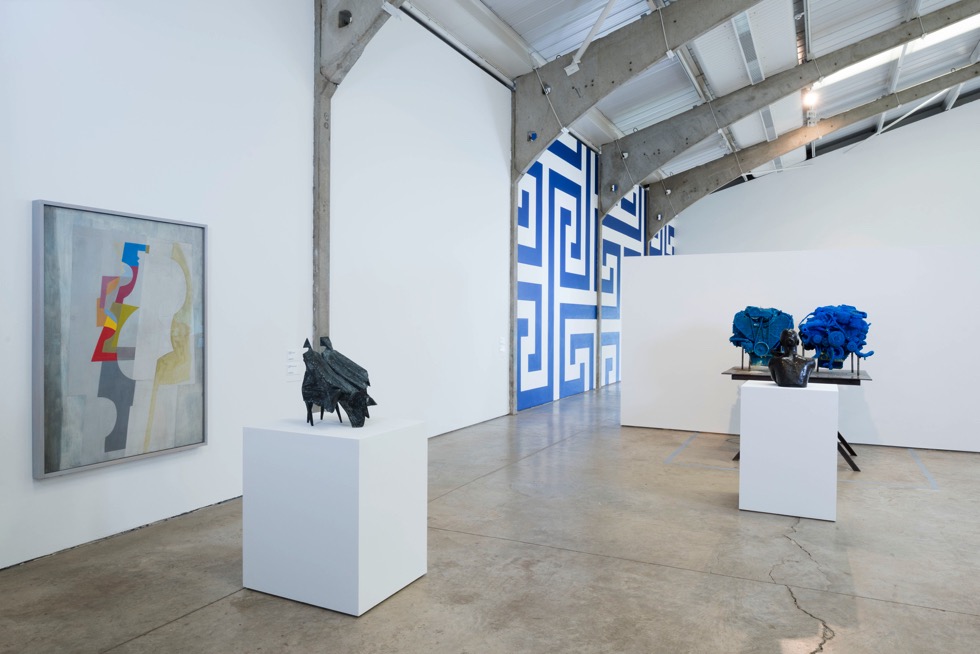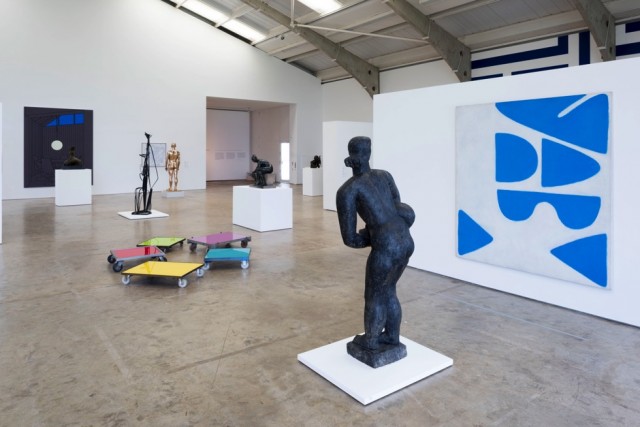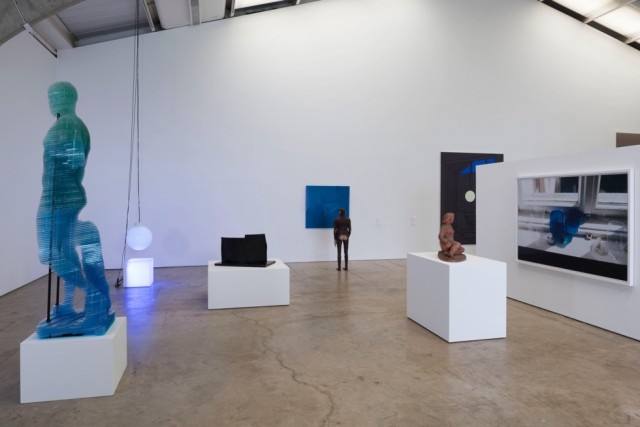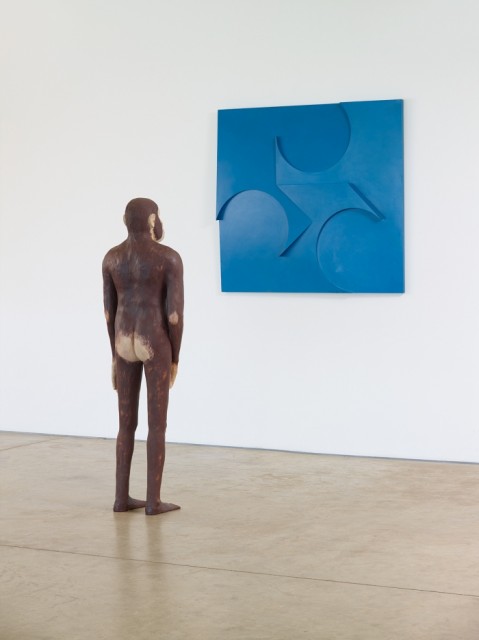“What would art say if it spoke?” — The Big Interview: Ryan Gander

Ryan Gander talks us through his curation of the Arts Council Collection’s 70th anniversary show, Night in the Museum — where the artworks gaze back…
In Ryan Gander’s current exhibition at Yorkshire Sculpture Park, Night in the Museum, all the artworks are looking at each other. So instead of entering the gallery to look at the works, the viewer is suddenly faced with things looking at other things; either ignoring the visitors completely, or (worse) making you feel like they’re watching you as you turn your back (hence the cheeky reference to Ben Stiller’s blockbuster film of a similar name). The gallery is animated with sculptures and paintings suddenly coming to life after years of living in dusty archives. The show starts a line of thought about what the artworks would say about each other if they could speak. It’s a shift in perspective, which is what Gander is good at, and recalls the mechanical cartoon eyes of Magnus Opus (2013).
Night in the Museum is a worthy — and touring — celebration of the Arts Council Collection’s (ACC) 70th birthday, featuring over thirty of their artists — including Angela Bulloch, Patrick Caulfield, Don Brown, Jacob Epstein, Liam Gillick, Roger Hiorns, David Hockney, Henry Moore, Ben Nicholson, Kerry Stewart, and Rebecca Warren – plus Gander’s new commission, As old as time itself, slept alone (2016), in which he re-imagines Edgar Degas’ The Little Fourteen-Year-Old Dancer (1880-81) in different stages of her life, against a blue cube.
The Double Negative: Hi Ryan! Tell us more about the pairings.
Ryan Gander: I had the idea that these two works would – in a conceptualised way – become a single work. So, each pairing, when you look at them, you don’t look at the pairs individually anymore. They become a work of two parts, by two artists, by this forced proximity.
I particularly enjoyed the Frank Dobson [Portrait Bust of Lady Keynes (Lydia Lopokova) (1924)] and Roger Hiorns [Nunhead (2004)] pairing – she seems completely enamoured with the glistening copper sulphate of the Hirons sculpture.
It’s funny; the artist has their own themes and perspectives in the construction of the work; but when you put them together, they still have those themes and perspectives that the artist originally intended for them, but they take on another meaning in their pairings. So, for example the Don Brown [Yoko XX (2007)] looking at the David Hockney [We Two Boys Together (1961)]: Brown’s is a sculpture of Yoko, his wife, so obviously the woman he’s in love with, so there’s some sort of reference to sexuality there. And the Hockney is a very early painting, made when he first came out as being gay. He showed it, then took it back to the studio, and that’s when he wrote the text on it and gave it the title, which alludes to his sexuality. So in this pairing, it takes on a whole new meaning, of the two works together.

It’s a very political show in a way, as I’m using artists’ work in a way that they may not have intended. They’ve (or their estate) all agreed to be in the show, and the curatorial premise of the show, and thought that the collisions were interesting. It’s an exhibition on a multitude of levels; its an exhibition on the role of the spectator in the space; its an exhibition of the ACC; its an exhibition of quite formal, figurative sculpture on relation to abstract, colour-field-based work… it’s fun.
I recently interviewed frieze editor Jennifer Higgie about her Paintings of People ACC exhibition, and she discussed how difficult it was to select works from such a massive collection, and how she set rules for herself in order to make the process a little easier. How did you decide on the rules you would use to make the selection, and these particular pairings?
Curatorally, and in space, physically, with Natalie [Rudd, Senior Curator, ACC]. Because they each have a gaze, and each gaze is in a certain direction, or at a certain height. Some go together and some don’t go together. If you look at the David Batchelor [I Love King’s Cross and King’s Cross Loves Me, 5 (2001)] over there [points], and the figure looking down [Uli Nimptsch, Seated Figure (1951)] (pictured, above centre), she was the only figure that could work as there wasn’t another figure looking down at the floor. So it sorts itself out. It really is auto-curation; but not to the point of chance.
I curated a show at Tate Britain called The Way In Which It Landed [2008]. They have these screens that pull out where they store all their work, and I just picked, using a dice, two of the screens, then asked them to hang both of these screens the way they were in storage, as a salon hang. And some were on their side and upside down; featuring jumps through time and history and schools and genres and geographical jumps. And this [Night in the Museum] is kind of like that. There’s sort of time travel implied, because you get the ultra contemporary, looking at the modern, looking at the antiquity.
There’s a social gulf between some of these works, too: like you mention Hockney’s We Two Boys Together, made six years before homosexuality was decriminalised.
Mmm. There are also a few things I added that weren’t in the collection: the video by Mexican artist Mario Garcia Torres [Sing Like Baldessari (Freestyle) (2004)], being looked at by The Little Sea Maiden [Frances Darlington (1905)] – I knew I wanted that in. It’s tongue in cheek… You can’t squash things together like this in the real world. There will be new things when the show goes to Birmingham – it’ll change a little bit each time throughout the tour.

With all that in mind, what type of questions did you have to ask yourself about the collection, given it is celebrating its 70th year? Or did you just concentrate on your own wishlist?
In a way, both were in mind. Essentially, it came down to the list of figurative works, and all the blue works, and it’s based on what I want to see. There’s no point being democratic about it; it had to come down to what I wanted to look at.
So there were no requests or rules from the ACC team?
Oh no. They called me up and asked me to do it, and I said: “Ohhh, sounds like a big job, will I get paid?” [Laughs] It’s been really good fun. I love doing things in the North, because I’m from here [Gander was born in Chester, studied in Manchester, taught at Leeds Met and Sheffield Hallam].
Which pairing did you enjoy the most?
It’s got to be the Kerry Stewart [Untitled (Lucy) (1996), staring at Garth Evans' Blue No. 30 (1964)] (below). When I was 16 years old, the British Art Show was in Manchester. My dad took me. It was the year with Damien Hirst and Gary Hulme, and Kerry Stewart, and she was really big then, but you don’t hear much about her much anymore. She still makes work, I know she teaches, and we did a residency together at Grisedale. So when I saw this in the collection, [I thought] this is just great. It refers to early man and woman, and obviously about human development; of intellect and creativity. She’s the one to me that alludes the most to what would art say if it spoke? If the objects came to life, like in the film [Night at the Museum]. [Laughs]
And what would Lucy say if she was able to speak?
I haven’t got a clue. I think I’m posing the question for other people to think about.

What interested me about the exhibition idea was that all sense of being self-conscious in the gallery, for whatever reason, somehow dissipates when you enter, and see all the works ignoring you, looking at each other.
It’s true. I think a lot of people, when they enter a gallery with the history and the elitism, they feel very self-conscious. But if you’re in here on your own, you’re not on your own, if you know what I mean.
Well, that’s true – they might turn round to look at you when you’re not looking! I have to ask you about this contentious quote that you gave in a BBC interview in 2014: “Painting is an illogical act”. Given the amount of paintings in this show, is the quote coming back to haunt you?
Painting is very illogical. It’s based in logic when you relate it to history, of course, because then there’s a reason to do it. Artworks that are not necessarily about the frivolous, self-satisfaction of painting, are very different to artworks that investigate the history of painting. It almost gives them a reason for them to exist.
Laura Robertson, Editor
See Night in the Museum: Ryan Gander Curates the Arts Council Collection at Yorkshire Sculpture Park until 16 October 2016 — FREE
Night in the Museum continues from 26 November 2016-12 February 2017 at The Gas Hall, Birmingham Museum and Art Gallery; and then from 25 February 2017-21 May 2017 at The Attenborough Centre, Leicester — see the ACC website for details





